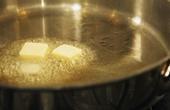Fats

Carbon, hydrogen and oxygen are compound frequent fat, which has a rather complex structure. It includes substances such as glycerin( chemical formula C3H8O3) and various fatty acids. Molecules of fat are formed from compounds of these substances. Such three fatty acids as oleic( C18H34O2), palmitic( C16H32O2) and stearic( C18H36O2) are the most common. The formation of one or the other fat depends on the combination of these fatty acids in the case of their combination with glycerin. Liquid fat, for example vegetable oil, is formed by the combination of oleic acid with glycerin. In the case of the combination of glycerin with palmitic acid, a harder fat is formed, which is the main component of human fat, and also forms part of the butter. Stearic acid forms even harder fats, such as for example fat.
To ensure the process of synthesis by the human body of a specific fat, all three types of fatty acids must be supplied to it. Fatty acids are divided into two types - saturated and unsaturated. Chemically, fats are formed from both types of fatty acids.
Unsaturated fatty acids contain many double and triple carbon bonds that readily enter into various chemical reactions. As a result, fats that contain a large amount of unsaturated fatty acids are much more quickly absorbed and less accumulated. Saturated fatty acids are mostly found in animal fats. This type of fat is digested much worse and much faster accumulates in excess in the body, in places such as subcutaneous fatty tissue, peritoneum and internal organs.
In addition to the fact that fats are a rich source of energy, they also form part of all tissues, organs and cells of the human body. They are also an integral part of protoplasm.
Fats begin to split in the stomach into their constituents( fatty acids and glycerol) under the influence of a substance such as lipase contained in gastric juice. Glycerin is easily absorbed, dissolving in water, and fatty acids do not dissolve in water at all. In the stomach can be split only fragmented into small particles of fat( eg, milk fat).
After the stomach, the food moves to the duodenum, where the juice of the intestinal glands, the pancreas, and bile flow to it, which also helps dissolve and absorb fatty acids. Lipase increases its effect 15-20 times under the influence of bile. Under these conditions, fats undergo further cleavage and are brought to such a state that it becomes possible for them to be absorbed into the blood and lymph. Further along the digestive tract, the food mass enters the small intestine, where, under the influence of intestinal juice, its final cleavage and absorption takes place.
Foods resulting from the splitting of fats, unlike the products of the breakdown of carbohydrates and proteins, are absorbed into the lymph, not into the blood. And glycerine and soaps in the process of passing through the cells of the intestinal mucosa, combine and again form fat. Thus, in the lymphatic vessel of the villi there are already droplets of newly formed fat, and not its constituents( fatty acids and glycerol). .. more
Materials used:
Shilov VN, Mitsio VP"Healthy food"
